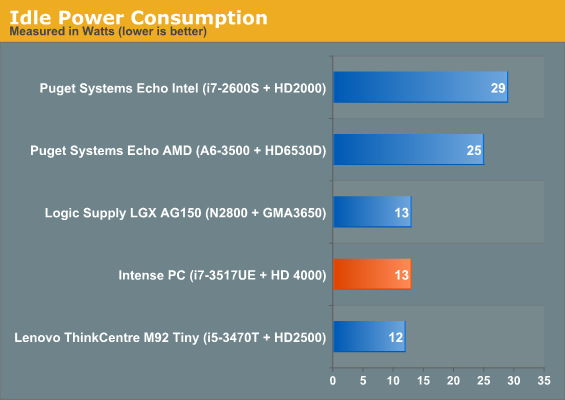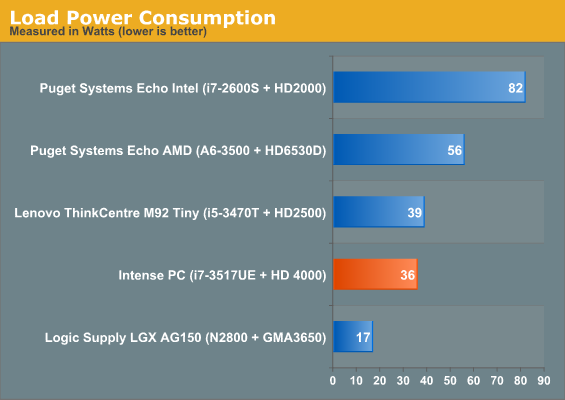CompuLab Intense PC System Review: Fanless Ivy Bridge
by Dustin Sklavos on April 20, 2013 12:01 AM EST- Posted in
- Systems
- Fanless
- Ivy Bridge
- desktops
- CompuLab
User Experience, Heat, and Noise
If absolutely nothing else, the user experience of the CompuLab Intense PC is a sound one. Since internally we're looking at a pretty basic Ivy Bridge-based system, there's no reason for anything to lack polish, and CompuLab wisely eschews Windows 8 entirely in favor of either Linux or Windows 7. The only place things really trip up are when you have to access the mechanical hard drive, but that's to be expected.
.jpg)
It should go without saying that the Intense PC is dead silent. The dense metal chassis prevents any of the sound of the hard drive from even escaping. The port layout is smart, and the system is surprisingly simple to service: a single screw holds a sliding panel on the bottom into place, and that panel holds the 2.5" drive. From there you can access the RAM and mini-PCIe slots.
Where things begin to get a little hairy is the heat. Since the Intense PC is, as I mentioned before, basically a big heatsink around a computer, that means that thermals can be come an issue. Internal thermals aren't really the problem, as you'll see below.

Getting heat off these components isn't a really big deal. The hard drive runs hot, but still well below spec, and the CPU runs comparatively frosty. Yet while the CPU's temperature isn't an issue, the temperature of the surface of the Intense PC is. At idle or under a modest load the Intense PC is safe to touch, but under stress I found the surface painfully hot. You're not cooking any eggs on it, and it's not going to produce third degree burns, but it's definitely too hot to actually handle. This isn't unexpected but it's definitely worth bringing up.
Power Consumption
There are no surprises to be had where power consumption is concerned, since we're talking about a 17W CPU, a QM77 chipset, and a hard drive specced to draw no more than 3W.


The Intense PC peaks at 36W, which is a little high but still totally reasonable. What I do find interesting is how competitive the higher wattage quad core ThinkCentre M92 is at both idle and load.


_thumb.jpg)
_thumb.jpg)
_thumb.jpg)
_thumb.jpg)
_thumb.jpg)
_thumb.jpg)








44 Comments
View All Comments
HisDivineOrder - Sunday, April 21, 2013 - link
Completely agree.Death666Angel - Monday, April 22, 2013 - link
I don't see the appeal of this thing for the normal consumer. In a business world where any moving part is a pain because of increased failure, downtime and service hours, I can see a completely fanless enclosure being great and paying a premium for it. For the consumer who wants a quiet HTPC, there are much better enclosures that offer silent fan configurations at better prices and more range in performance. :) I have a slightly modded mITX case where the top-blower CPU heatsink/fan draws cool air from the outside and pushes it out through the 2 sides. I don't hear anything.Don't get me wrong, this thing is cool, but I don't think it is worth the price for consumers unless you have a tiny room. :D
mgc8 - Saturday, April 20, 2013 - link
I had a previous version of one of these (the FitPC2) and while small and quiet, it suffered from terrible heat problems -- it basically had to be rebooted once a day since it was locking up hard. As the intended purpose of the device was to serve as a router/gateway, needless to say it had to be replaced with another product. I would've appreciated a more thorough investigation of this device's resilience in 24/7 operation under high network load, as that is one of the most obvious use cases.Intense PC user - Saturday, April 20, 2013 - link
I guess Phoronix uses this model for more than half year as basis for Intel HD 4000 "Ivy Bridge" benchmarks:http://www.phoronix.com/scan.php?page=article&...
HellDiver - Saturday, April 20, 2013 - link
So is this just a NUC board in a custom case? Specs seem terribly similar.cjs150 - Monday, April 22, 2013 - link
At moment NUC is an i3 processor not an i7 (although I believe an i5 version is coming out shortly). From experience the i3 runs a bit too hot at idle for my liking (around 50C) unless you ramp up the fan when it becomes a bit too noisy.There are very few applications where a completely silent computer is needed (HTPC being the obvious one) I have a completely silent computer which can be run 24/7 but I always worry about heat for the memory
zepi - Saturday, April 20, 2013 - link
How about a comparison with Intel DQ77KB + Akasa Euler?We can just hope that Intel releases similar packages for Haswell later this year.
danjw - Saturday, April 20, 2013 - link
With Haswell release only 43 days out, I don't see why anyone would be releasing and Ivy Bridge product now. It just doesn't make any sense to me.kyuu - Sunday, April 21, 2013 - link
Just because Haswell is getting "launched" in 43 days doesn't mean you'll see products shipping with it immediately after. I'm guessing Haswell will probably be in short supply at first.ViewRoyal - Saturday, April 20, 2013 - link
So this CompuLab PC is:- about the same size as the quad-core Intel Core i7 Mac mini,
- but it weighs more than the quad-core Intel Core i7 Mac mini,
- has less connectivity than the Mac mini,
- has a much less powerful processor than the Mac mini's quad-core Intel Core i7,
- has less storage than the quad-core Intel Core i7 Mac mini,
- and it costs MUCH more than the quad-core Intel Core i7 Mac mini.
On top of that, the CompuLab PC can only run Windows and Linux... the Mac mini can run OS X, and Windows, and Linux.
Why would anyone want buy this black lump???